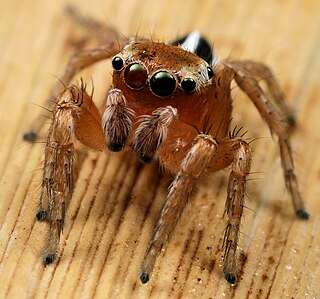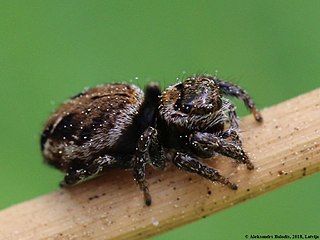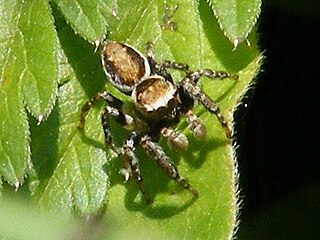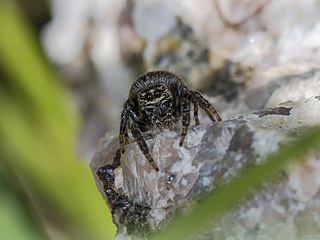
Evarcha vittula is a species of jumping spider in the genus Evarcha that lives in South Africa. The species was first described in 2011 by Charles Haddad and Wanda Wesołowska. The spider is small, with a carapace measuring between 2.4 and 3.2 mm long and an abdomen between 2.5 and 3.6 mm long. There is a delicate scutum on the abdomen. The spider is generally dark brown but there is an orange streak down the middle of the upper surface of both the abdomen and carapace. This streak helps distinguish the spider from others in the genus. It can also be identified by its copulatory organs. The male has a characteristic short straight embolus. The female has not been described.

Evarcha flagellaris is a species of jumping spider in the genus Evarcha that lives in Kenya and South Africa. The species was first described in 2011 by Charles Haddad and Wanda Wesołowska. The spider is small, with a carapace measuring between 2.0 and 2.4 mm long and an abdomen between 1.9 and 3.6 mm long. The female is larger than the male, particularly in the size of its abdomen. Both have stripes on the abdomen, the male being more distinct with four brown stripes contrasting with a yellow background. This is similar to the related Evarcha striolata, from which it can be distinguished by the presence of an orange scutum. It can also be identified by its copulatory organs. The female has very wide looping insemination ducts that lead to heavily sclerotized multi-chambered spermathecae. The male has a long straight projection from its tibia or tibial apophysis and a whip-like embolus. It is after the latter feature that it is named.

Evarcha brinki is a species of jumping spider in the genus Evarcha that lives in Northern Cape, South Africa. The species was first described in 2011 by Charles Haddad and Wanda Wesołowska. The spider is small, with a carapace measuring typically 2.5 mm (0.10 in) long and an abdomen 2.1 mm (0.08 in) long. It is generally yellow, with an orange tinge to the top of the carapace and a darker, nearly black eye field. There are large black spots on the abdomen. While the majority of the legs are yellow, the front pair are brown. It is very different to other African Evarcha spiders. Its copulatory organs are distinctive, particularly the male's embolus, which is short and encircled by a very thin appendage. The female has not been described.

Evarcha acuta is a species of jumping spider in the genus Evarcha that lives in Namibia, Seychelles and South Africa. The species was first described in 2006 by Wanda Wesołowska. The spider is small, with a carapace measuring typically 1.6 mm (0.06 in) long and an abdomen between 1.4 and 1.9 mm long. The carapace is light brown with a short black eye field. The abdomen has patterns that vary depending on geography. The holotype, found near Brandberg Mountain in Namibia, has lines of brown patches on the top. Examples found in Free State, South Africa, have black lines on the top and sides. The spider can be most easily distinguished from other spiders in the genus by its copulatory organs. The male has a distinctive notch on a long straight projection from its tibia known as a tibial apophysis and a long embolus. The female has not been described.

Evarcha mirabilis is a species of jumping spider in the genus Evarcha that lives in South Africa. The species was first described in 2009 by Wanda Wesołowska and Charles Haddad. The spider is small, with a dark brown carapace measuring typically 1.9 mm (0.07 in) long and a russet-brown abdomen that is typically 1.7 mm (0.07 in) long. It is similar to related species in the genus, particularly Evarcha maculata and Evarcha patagiata. The spider has a yellow pattern on the top of its abdomen, its underside being a uniform yellow, while the underside of the carapace is orange. The legs individually have a pattern of yellow, black, yellow. The pedipalps are similarly yellow and black. The male can be distinguished from others in the genus by its copulatory organs, particularly the shape of the projection from its palpal tibia or tibial apophysis, which is short and sharp and connected to the tibia through a large base. The female has yet to be described.

Evarcha aposto is a species of jumping spider in the genus Evarcha that lives in Ethiopia and Nigeria. The species was first described in 2008 by Wanda Wesołowska and Beata Tomasiewicz. It is named for the place in Ethiopia where is was first found. The spider is small, with a cephalothorax measuring between 1.9 and 2.2 mm long and an abdomen between 1.8 and 1.9 mm long. The carapace is generally light, yellow or fawn, with a dark stripe down the middle and occasionally a thin stripe to the rear. The abdomen is yellow with a pattern of darker patches. It has a black eye field. The front legs are darker, brown in the case of those found in Nigeria and black for the Ethiopian examples. The remaining legs have a distinctive top half that is black or brown, the remainder being yellow. Its copulatory organs are distinctive, particularly the male's very short embolus, which is accompanied by a spoon-like appendage. The female has not been described.

Evarcha awashi is a species of jumping spider in the genus Evarcha that lives in Ethiopia. The species was first described in 2008 by Wanda Wesołowska and Beata Tomasiewicz. The spider is small, with a cephalothorax measuring between 2.0 and 2.3 mm long and an abdomen between 1.9 and 2.4 mm long. The male and female are similar in size but differ slightly externally. The male carapace is orange while the female is brown, both with a darker eye field. The pattern on the abdomen is generally similar, a combination of light background and dark patches, but the female has less contrast between the two. The legs are mainly brown with yellowish tarsi. Its copulatory organs are distinctive. The male has a short embolus that follows the palpal bulb and a sharp tooth on its short wide and blunt protrusion on its palpal tibia, or tibial apophysis. The female has insemination ducts that narrow into multi-chambered spermathecae.

Evarcha pinguis is a species of jumping spider in the genus Evarcha that lives in Ethiopia. The species was first described in 2008 by Wanda Wesołowska and Beata Tomasiewicz. The spider is larger than others in the genus, with a cephalothorax measuring 3.4 mm (0.13 in) long and an abdomen between 4.7 mm (0.19 in) long. The spider is dark brown and hairy apart from a lighter streak on the back of the carapace and a pattern of light chevrons down the back of the abdomen. The legs are brown, the front four being thicker and shorter than the rest. The copulatory organs are distinctive. The female has marked sclerotization to the edge of its epigyne. The male has not been described.

Evarcha rotundibulbis is a species of jumping spider in the genus Evarcha that lives in Ethiopia. The species was first described in 2008 by Wanda Wesołowska and Beata Tomasiewicz. The spider is small to medium-sized, with a cephalothorax measuring between 2.4 and 2.7 mm long and an abdomen between 2.3 and 2.6 mm long. The carapace is light brown with a dark brown eye field. The abdomen is russet with a yellowish pattern of arrows and spots. The spider has brown and yellow legs. Its copulatory organs are unusual and help identify it. The male has a distinctive rounded palpal bulb that is recalled in the name of the species. It also has a very short forked embolus and a shovel-like projection, or apophysis, on the palpal tibia that distinguishes it from other related species. The female has not been described.

Evarcha russellsmithi is a species of jumping spider in the genus Evarcha that lives in Ethiopia. The species was first described in 2008 by Wanda Wesołowska and Beata Tomasiewicz. The spider is small to medium-sized, with a cephalothorax measuring typically 2.2 mm (0.09 in) long and an abdomen 1.8 mm (0.07 in) long. The carapace is yellowish with dark rings around the spider's eyes. The abdomen is brown with an indistinct pattern of spots and lines. The legs are generally brown. The copulatory organs are distinctive. The male has a projection, or apophysis, from the palpal tibia that is has a series of tooth-like features, and a very short embolus that is attached to another very small apophysis. The female has multi-chambered spermathecae and distinctive accessory glands.

Evarcha bakorensis is a species of jumping spider in the genus Evarcha that lives in Guinea, Ivory Coast and Nigeria. It thrives in savanna grasslands. The species was first described in 2002 by Christine Rollard and Wanda Wesołowska. The spider is small, with a cephalothorax measuring between 1.6 and 1.8 mm long and an abdomen that is between 1.3 and 1.9 mm long. The female is larger than the male. The cephalothorax has a light brown topside, or carapace, yellow underside, or sternum, and darker sides. The abdomen is greyish-brown or brown and has a lighter pattern on it. The spider has generally brown legs. It has distinctive copulatory organs. The female has a large membrane in the centre of its epigyne while the male has a straight and blunt tibial apophysis, or projection on its palpal tibia.

Evarcha certa is a species of jumping spider in the genus Evarcha that lives in Guinea and Ethiopia. It thrives in grasslands, particularly near bodies of water like the Baro River and in areas of high altitude such as the Guinea Highlands. The species was first described in 2002 by Christine Rollard and Wanda Wesołowska. The spider is small, with a cephalothorax measuring between 2.6 and 2.9 mm long and an abdomen that is between 2.7 and 3.4 mm long. The cephalothorax has a reddish-brown topside, or carapace, with a darker eye field, and an orange underside, or sternum. The abdomen has a pattern consisting of irregular brown patches, although this differs between individual spiders. The spider has orange or yellow legs. It has distinctive copulatory organs. The female has relatively simple spermathecae that are heavily sclerotized and short insemination ducts. The male has not been described.

Evarcha maculata is a species of jumping spider in the genus Evarcha that lives in Guinea, Ivory Coast and Ethiopia. It thrives in savanna, particularly in the Guinea Highlands and near bodies of water like the Awash River. The species was first described in 2002 by Christine Rollard and Wanda Wesołowska. The spider is small, with a cephalothorax measuring between 1.7 and 2.3 mm long and an abdomen that is between 1.6 and 3.6 mm long. The female is generally larger than the male, although there are exceptions, particularly amongst those found in Guinea. The cephalothorax has a yellowish topside, or carapace, with a darker eye field, and an yellow or yellowish-orange, or sternum. The abdomen has a distinctive pattern that is basically shaped like a capital "H", referred to in the species name, which can be translated "spotted". The spider has orange or yellow legs. It has distinctive copulatory organs. The female has distinctively shaped insemination ducts. The male has a very short curved embolus.

Evarcha grandis is a species of jumping spider in the genus Evarcha that lives in Nigeria. The species was first described in 2011 by Wanda Wesołowska and Anthony Russell-Smith. It is larger than typically for the genus, which is reflected in the species name derived from the Latin word that means "large". The spider has a cephalothorax that is typically 3.6 mm (0.14 in) long and an abdomen 5.7 mm (0.22 in) long. It has a brown carapace with a black eye field and greyish-brown abdomen. It has long brown bristles on its clypeus, or face, and white lines on its cheeks. The spider's legs are dark brown. Apart from its size, the spider's copulatory organs are the most clear way to identify it. The female has pockets towards the midpoint, rather than the rear, of its epigyne, short insemination ducts and large spermathecae. The male has not been described.

Evarcha arabica is a species of jumping spider in the genus Evarcha that lives in Yemen. The species was first described in 2007 by Wanda Wesołowska and Antonius van Harten. The spider is small, with a carapace that measures between 2.1 and 2.7 mm long and an abdomen that is between 1.8 and 3.2 mm long. The female is generally larger and lighter than the male. The spider's eye field is darker. The top of the male abdomen is blackish-brown with a pattern of white dots and a large yellowish-orange belt. The top of the female abdomen has similar white dots but is mainly yellow with small darker dots. The male's legs are brown and yellow while the female's are orange to yellow. It has distinctive copulatory organs. The female has accessory glands near the copulatory openings and simple bean-like spermathecae. The male has a thin embolus and a tibial apophysis that has a forked tip.

Evarcha picta is a species of jumping spider in the genus Evarcha that lives in Yemen. The species was first described in 2007 by Wanda Wesołowska and Antonius van Harten. The spider is small, with a carapace that measures between 2.4 and 2.6 mm long and an abdomen that is between 2 and 2.4 mm long. It has a distinctive pattern on its abdomen that is recalled in its name, which can be translated "patterned", which includes a series of white dots and chevrons. The pattern is less clear on the female than the male. Otherwise, the spider is generally brown and yellow. The male's legs are brown and yellow while the female's are yellow. There is a characteristic fovea, or indentation, in the centre of the carapace. It has distinctive copulatory organs. The female has a large depression in the centre of its epigyne and narrow insemination ducts that lead to long accessory glands and small spermathecae. The male has a terminal apophysis that makes it look as if its embolus has two branches. The spider's brownish-orange clypeus is also an identifying trait.

Hyllus rotundithorax is a species of jumping spider in the genus Hyllus that is endemic to Tanzania. It lives near rivers. The spider was first described in 2000 by Wanda Wesołowska and Anthony Russell-Smith. The spider is large, with a brown carapace 5.8 mm (0.23 in) long and an abdomen 6.8 mm (0.27 in) long. The species has a distinctive rounded thorax, after which it is named, and a long thin embolus. Only the male has been identified.
Detalik idanrensis is a species of jumping spider in the genus Detalik. It is endemic to Nigeria and was first described in 2021 by Wanda Wesołowska. A small spider like all those in the genus, it has a cephalothorax measuring typically 1.9 mm (0.07 in) long and an abdomen typically 1.7 mm (0.07 in) long. The cephalothorax has a brown top, or carapace, with a thin lighter line running down it and a light brown underside, or sternum. The abdomen is yellow underneath butalso brown on top with a lighter streak running down much of the surface. The spider has distinctive copulatory organs. The female has unusually large large spermathecae, or receptacles. The male has not been described.

Phintella occidentalis is a species of jumping spider in the subfamily Salticinae that lives in Ivory Coast. First described by Wanda Wesołowska and Anthony Russell-Smith in 2022, the species is named after the Latin word for western as it is found in West Africa. The spider is small, with a cephalothorax between 2.3 and 2.8 mm long and an abdomen that is between 3.1 and 3.5 mm long. The female is smaller than the male. The carapace is brown, the female light and the male dark. The abdomen is yellow and is marked by two wide brown stripes on the female and a grey streak on the male. It is the abdominal pattern that most clearly distinguishes the species from others in the genus. The copulatory organs are also different. The male has a longer tibial apophysis, or appendage and the female has seminal ducts that diverge and then converge.

Phintella globosa is a species of jumping spider in the genus Phintella that lives in Ivory Coast. First described by Wanda Wesołowska and Anthony Russell-Smith in 2022, the spider is small, with a cephalothorax typically 2.1 mm (0.083 in) long and an abdomen 2.0 mm (0.079 in) long. Only the female has been described. The carapace is dark brown and the abdomen yellow. Although similar to the related Phintella lucida, the copulatory organs are distinctive. The spermathecae are particularly large and spherical, which is recalled in the species name.
















